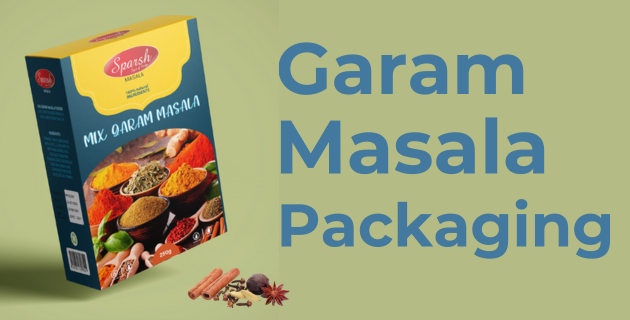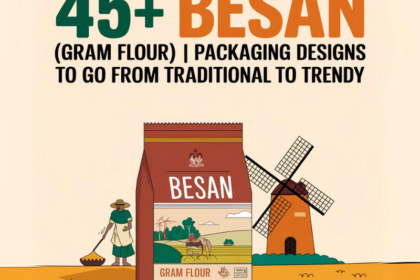Garam Masala’s History
Garam Masala has its own importance in Indian kitchens, used in Indian cooking for centuries. Its high aromatic spice blend combines various ingredients like cardamom, cinnamon, cloves, and black pepper, each with unique flavors and health benefits.
Historically, women in Indian households used to sun-dry each ingredient, grinding them manually to create their perfect mix. This ensured freshness and purity in every pinch. With time many brands like MDH and Everest started packaging garam masala, making it more accessible to modern Indian woman. Apart from its aroma and flavor, garam masala helps digestion, boosts immunity, and act as anti-inflammatory properties, making it both a culinary and medicinal staple.
Garam Masala Packaging Design Guide
As a packaging designer, it is essential to combine cultural authenticity with modern branding techniques to ensure the product not only represents its heritage but also stands out on retail shelves. We divide garam masala packaging into two crucial parts: the front and the back. Each element plays a vital role in creating a compelling and functional design.
Front of the Pack Design
– Dark Color Palette
Rich, dark hues like deep maroon or black evoke a sense of luxury and tradition, instantly catching attention and reflecting the premium quality of the garam masala inside.

Source: in.pinterest.com

Source: in.pinterest.com
– Cultural & Health Motifs
Incorporate traditional Indian patterns, such as paisleys or mandalas, alongside subtle health-related symbols to connect with cultural roots and highlight the product’s wellness benefits.

Source: in.pinterest.com

Source: in.pinterest.com
– Clear Brand Logo and Name
Position the logo prominently at the top-center or top-left corner, ensuring it’s easy to identify and reinforces brand recall in a crowded market.

Source: in.pinterest.com

Source: in.pinterest.com
– Main Ingredient Images
Highlight key ingredients like cardamom pods, cinnamon sticks, and cloves with high-quality visuals to assure customers of the product’s authenticity and quality.

Source: in.pinterest.com

Source: in.pinterest.com
– Mouthwatering Dishes Image
Showcase vibrant images of dishes like biryani or curry made with garam masala to inspire culinary ideas and create an emotional connection with the consumer.

Source: in.pinterest.com

Source: in.pinterest.com
-Pure and Authentic Seal Design
Add a visually appealing seal or badge that states “100% Pure” or “Authentic Blend” to build trust and emphasize the product’s originality.

Source: in.pinterest.com

Source: in.pinterest.com
– Shelf Appeal Design
Focus on clean layouts and contrast to ensure the package stands out in retail spaces while maintaining a balance between modern aesthetics and traditional elements.

Source: in.pinterest.com

Source: in.pinterest.com
– Bold Typography
Use bold, legible fonts for key features like “Premium Garam Masala” or “Handpicked Spices” to immediately grab the consumer’s attention.

Source: in.pinterest.com

Source: in.pinterest.com
Back of the Pack Design
– Usage Instructions and Recipes
Include simple, easy-to-follow instructions and a short recipe to educate and inspire customers on how to use the garam masala effectively in their cooking.

Source: behance.net

Source: behance.net
– Nutritional Info
Provide clear nutritional information as per the FSSAI guidelines, highlight health benefits like “Rich in Antioxidants” or “Boosts Immunity” .

Source: in.pinterest.com

Source: in.pinterest.com
– Barcode and Legal Compliance Details
Ensure the barcode, manufacturing date, expiry date, and FSSAI compliance are clearly visible and organized to maintain trust and meet regulatory requirements.

Source: dribbble.com

Source: dribbble.com
– Highlight Source of Spices
Mention the origin of the spices, such as “Sourced from Kerala” or “Handpicked from Indian Farms,” to add credibility and create a premium feel.

Source: in.pinterest.com

Source: in.pinterest.com
– Clear Net Weight and MRP Display
Display the net weight and price in a bold, easily readable font, ensuring transparency and ease of purchase for consumers.

Source: in.pinterest.com

Source: www.behance.net
Conclusion
Garam masala is more than just a spice blend; it’s a symbolic ingredient of Indian curry worldwide. Designing its packaging is an opportunity for brand owner to tell a story—one that celebrates tradition while catering to modern sensibilities. The front of the pack should attractive with cultural motifs, vibrant images, and bold typography, while the back must inform and educate with clear instructions, nutritional info, and transparent details.




